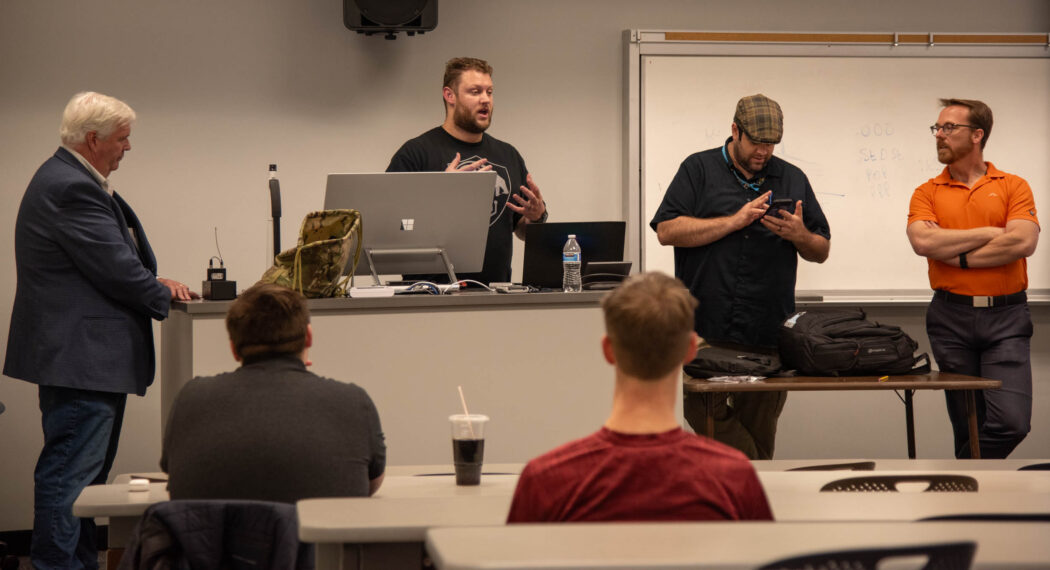Ignite Engineering funds student-led projects
The Institute of Electrical and Electronics Engineers is a nationally recognized organization seeking to advance the field of engineering and connect students with experienced mentors. IEEE also focuses on student-led projects and hands-on work with engineering.
Mark Soulier, a second-year electrical engineering student, is both an officer in IEEE and Utah State University’s robotics club president. Soulier has been a part of IEEE for a year and a half, and his family’s involvement with the organization spans decades.
“My dad was actually in IEEE when he went to college like 25 years ago,” Soulier said. “I met another upperclassmen and I was like, ‘This actually seems like a really cool path to make a difference.’”
Blaine Campbell, a third-year student majoring in computer science, joined Soulier in IEEE and is now the treasurer.
“Mark was like, ‘Hey, you should join this.’ I was like, ok, because we’re in robotics and said, ‘Sure, why not?’” Campbell said.
IEEE encompasses all of the clubs and associations within the electrical engineering department. The members are typically involved in the other clubs as well. This setup allows a variety of students interested in engineering to work on their preferred projects and engineering specialties.
“IEEE oversees the USU Robotics club — which I help run as well — but also oversees the Tesla Coil club and all these different sub clubs,” Soulier said. “IEEE as a whole is the largest professional engineering organization actually in the world.”
Because of IEEE’s considerable size, its members are able to plan a variety of different events.
“It’s kind of just an opportunity for students to plan events, for students to come to and be able to get hands-on experience,” Soulier said. “They do a lot of workshops like learning to do the Raspberry Pi program, learning to solder and to 3D print — just all different types of applications students don’t really get to learn inside the classroom.”
Recently, USU’s chapter of IEEE launched a new program called Ignite Engineering. This program will offer not only mentoring, but funding for student-led projects.
“It’s a grant of up to $100 to support these small projects,” Soulier said. “There’s very few requirements so a lot of students can do it.”
Soulier and Campbell thought up the Ignite Engineering initiative this past summer after attending IEEE workshops and finding students wanted to utilize the skills they were learning in class to bring their own ideas to fruition.
“We just got funding from the College of Engineering to support up to 40 students now for this semester,” Soulier said. “We’re testing it out with a few small groups of students at a freshman and sophomore level who will be able to have mentors here at IEEE.”
Students hoping to receive the funding will fill out a survey estimating the projected cost, how they plan to accomplish the project and why they’re passionate about it.
“Every Wednesday, as part of our officers meeting, we go over all of the proposals submitted that week to kind of see what their idea was,” Soulier said. “If we think it’s something that they can do and we can support, we get them a mentor from the club to talk over milestones with them.”
Ignite Engineering also has a virtual platform where students can simultaneously view other student’s projects and post their own.
“Students can see that others are also working on these different, interesting projects and collaborate on those and meet students they wouldn’t otherwise — students across disciplines and that you wouldn’t meet in your classes,” Soulier said. “Different types of engineers, different types of people.”
Ignite Engineering is still in its guinea-pig phase, with four projects and 10 students. However, Soulier said next semester will support around 30 students with numbes rising as the program develops.
One of these projects is the Ruben’s Tube, which is headed by fourth-year electrical engineering student Andrew Hendricks.
“Essentially, you take a pipe, drill a whole bunch of holes in the top of it, seal off one end with something hard like wood or metal and the other with a balloon. Then you feed propane into it,” Hendricks said. “What happens is we can send a sound wave through the balloon.”
Hendricks explained once these sound waves are generated in the tube at the right length and frequency, standing waves are produced.
According to Indiana.edu and diginole.lib.edu, standing waves are conceptually how instruments create sound. A Ruben’s Tube is a physical representation of those waves as peaks of fire.
The Ruben’s Tube is just one of many projects either funded by Ignite Engineering or crafted by the IEEE team, all of which have been compiled into a gallery on the Ignite Engineering platform.
Those participating in Ignite Engineering look forward to the new students and projects the next semester will bring and to upholding IEEE’s mission of technological innovation.

